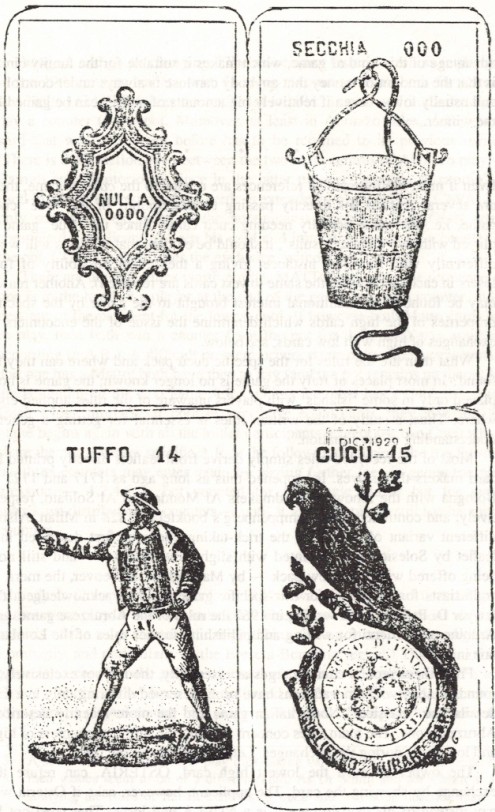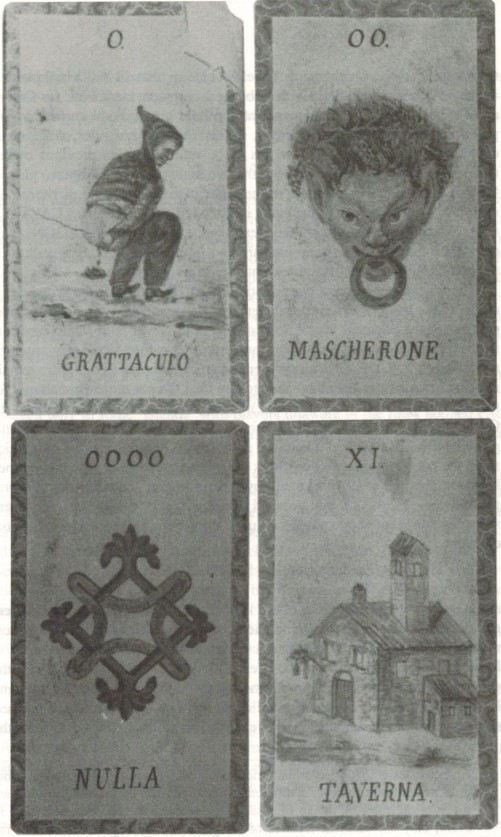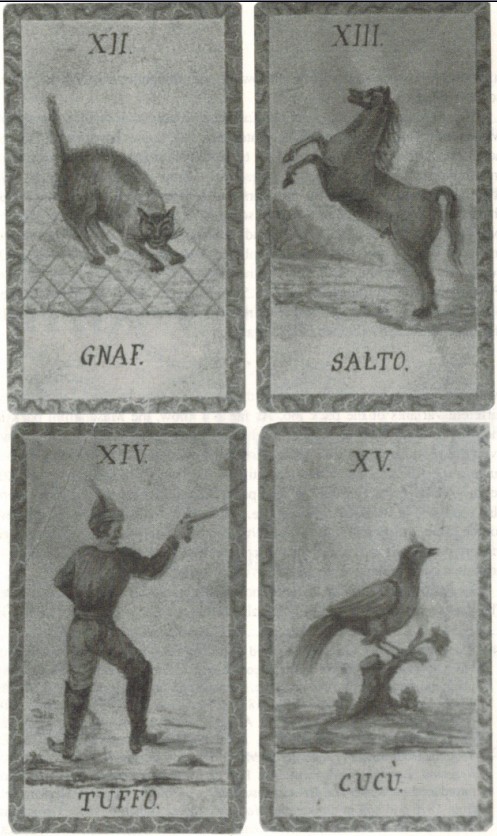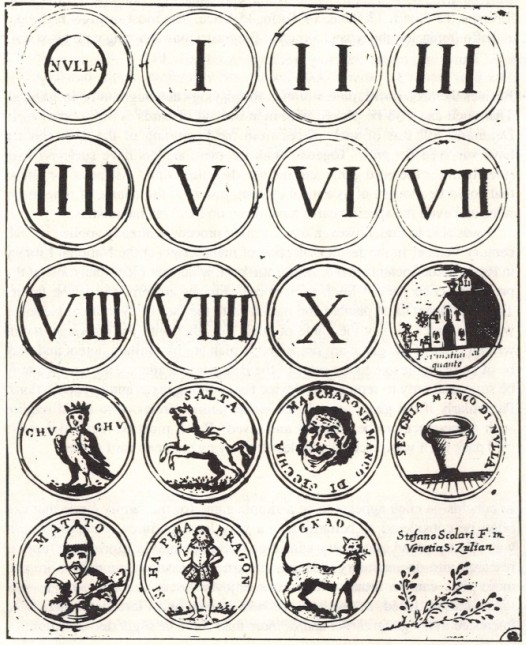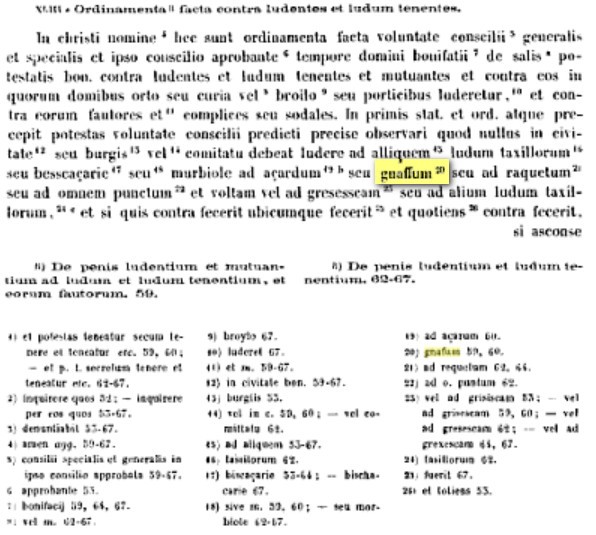|
The game of cuc¨ is one of the very few card games that has a special pack of its own. Generally, most packs other than standard four-suited ones have a short life; this one is already almost three hundred years old. Moreover, its distribution is really considerable since the pack is known - of course, in several variants - from southern Italy to northern Scandinavia. Therefore, research into documents on the cuc¨ pack and the game appears worthwhile. A remark may be devoted to the suggested origin of cuc¨ as a bungled - verballhornt (Hoffmann) - form of tarot; although some analogy can be found, such as the matto occurring outside the overall sequence, a direct derivation is not at first sight evident.
A study of the Italian cuc¨ literature has recently been carried out.(1) Certainly, many mentions of the cuc¨ game can be found in books of the 'Complete Hoyle' kind. However, most of them refer to a variant which can be played with the standard pack. This 'simplified' game has also been a favourite in family circles in several parts of Great Britain (ranter go round) and France (coucou). The French game, in particular, has left many traces since it was included in the "Academies des jeux" and, thence, in many collections of games which were simple translations or compilations of the French original. It is now difficult to ascertain whether the cocu mentioned as long ago as in Rabelais' list is same game but this variant is certainly a traditional old one, either with its name or with others as hŔre or mÚcontent.(2)
The general outline of the main game that is played with the cuc¨ pack is to be seen in the games of the coucou kind. A card is dealt to everybody in a circle, with the possibility of exchanging it once with that of the neighbouring player. The only exception here is given by kings, which can refuse the exchange. At the end, the player or the players with the lowest cards lose part of the total stakes. Generally, the stakes are represented by three counters and one of them is lost at a time. A player who exhausts his counters is eliminated. The game goes on until a single player remains and he wins the pot. The advantage of this kind of game, which makes it suitable for the family circle, is that the amount of money that everybody can lose is always under control - and usually low - even if relatively big amounts of money can be gained by the winner.
Even if most bibliographical references are related to the coucou game, there are several reasons for directly passing to descriptions of the 'true' cuc¨ game, i.e., the game actually needing cuc¨ cards. Since the 'true' game is played with two identical 'suits', it should be evident that the laws will work differently with four (for instance, giving a theoretical possibility of four losers in each game when the same lowest cards are received). Another reason may be found in the additional interest brought to the game by the specific properties of the high cards which determine the issue of the encounters in exchanges of high with low cards, see below.
Which are then the rules for the specific cuc¨ pack and where can they be found? In most places of Italy the game is no longer known; the game is now played only in some 'islands' with players unaware of the rules applied elsewhere. Thus, a study of the written rules is essential for getting a general outlook on the situation.
Most of the recorded rules simply derive from leaflets directly printed by card makers themselves. It happened thus as long ago as 1717 and 1722 in Bologna with the renowned cardmakers Al Mondo and Al Soldato, respectively; and continued with Gumppenberg's booklet of 1824 in Milan. Also a different variant of the game, the trick-taking one, was first described in a leaflet by Solesio, then reprinted with slight amendments - and still now being offered with each new pack - by Masenghini. Moreover, the merit of enthusiasts for cards and for this specific game must be acknowledged: the lawyer Di Pancrazio for writing in 1962 the rules of the Abruzzese game, and Arduino and Arienti for writing and publishing further rules of the Lombard one in 1984.
From these reports cuc¨ emerges as essentially, though not exclusively, a round game. Two main traditions have been preserved differing only in a few details, the "classical" North-Italian game and the more recently described Abruzzese one. The main rules concern the solution of the encounters of high and low cards during the exchanges. Let us briefly examine them.
The owner of even the lowest high card, OSTERIA, can refuse the exchange by showing the card. The applicant, however, asks if Osteria will pay instead of his card in case it is a NULLA and loses. That need not be true: the risk of such a possibility often urges the holder of Osteria to choose to change it and go on changing. (The association Osteria-Nulla is explained, in the 19th century leaflets, with O being a common mark both for Osteria and Nulla.) GATTO forces the applicant to hold his card and to immediately pay a counter to the pot. Moreover, at least in Abruzzo rules, A.R., every card that was exchanged before has to be returned to its previous owner. (There is a distinction even between the two main centres of Abruzzo play - Campli and Montorio - since in the latter place a "gnaffata di ritorno" is used in which the return of the cards is extended a place further.) CAVALLO only passes the exchange to the next-nearest neighbour. BRAGON again compels the applicant to keep his card and immediately to pay a counter to the pot. CUC┘ only refuses the exchange, without any penalty.
There are other features worth noting. MATTO is outside the sequence. If one is in the hand of a player at the end of the game he pays a counter, independent of the payment for the lowest card. If however both Matto cards are in play, then both win a counter from the pot (or they don't pay anything according to A.R.). A difficult problem occurs when only two players remain and one has a Matto: both have then to pay (and the pot remains unaltered for the beginning of the next game A.R.), unless the other has a Cuc¨, when the Cuc¨ wins. Similarly, if both players have equal cards, they lose and the game begins again with all the initial participants, except for two Cuc¨ which share the pot. Another specific A.R. is the following: a player who has finished his three counters may enter again by paying further fees in geometric progression - 1,2,4,8,... not counted for the single player but for every successive distribution of counters - until at least one player still has his initial counters.
Already in Gumppenberg's book of 1824 it was clearly stated that different games were played with same pack elsewhere in Italy. Of them we have records of the rules for one, the trick-taking variant most recently played in Lombardy, and particularly in the Brescia-Bergamo region.(3) The basis of the game is to consider the pack as formed by two suits, Numbers (I to X) and Figures. Those "suits" have to be followed by players. (Generally, a partnership game is played among four players.) As usual, the highest card wins the trick and its owner leads for the following one; the game ends when a given score is reached.
Two different rules are described for the card points. Solesio, followed by Masenghini and Fantini-Santelia, states that the value corresponds to the actual number written on the cards, 1 to 10 for Numbers, 11 to 15 for counting Figures while the five low figures, with Matto lowest, don't count. We thus have twice 55 points for numbers and 65 for figures. Leone should be the second-lowest card here. No final score to be reached is reported; perhaps payments occurred in each hand. Instead, Arduino reports a "simplified" version in which I to IV and the four unnumbered Figures count nothing; V to IX count one half; X, the numbered Figures and Leone (promoted to the highest Figure) count 1. We thus have twice 3.5 points for Numbers and 6 for Figures - with an even greater difference of relative value between the two suits. In this case, the score to be reached for game is 41.
After examining different variants for the games, it may be useful to examine different variants for the pack too. As far as I know, the Masenghini pack is the only one which is at present used for play in Italy. Many makers, however, did produce such cards in the past. Hand painted packs were also in use, such as the Abruzzo specimen in the figure. The main production of the 18th century came from Bologna; a few packs (20 dozen packs stamped) were also produced in Florence for local use. Milan seems to have been the greatest source from the beginning of the 19th century. Successively, several card makers produced cuc¨ packs also in other towns so that it is now difficult to provide a comprehensive list of Italian makers of cuc¨ packs.(4)
Only several examples of the less known Abruzzo pack will be shown here (pictures see below in Appendix). The pack is of 40 cards and they are all used in the game. As usual, Matto is unnumbered and outside the sequence. The 20th and lowest card, Cacaccio, has the meaning of dysentery and is marked by 0, then follow 00 Mascherone, 000 Secchia, 0000 Nulla, the usual ten numerical values, 11 Taverna, 12 Gnaff, 13 Salta, 14 Tuffo, 15 Cuc¨. The most original high card is Tuffo (replacing the typical Venetian Bragon) a man shooting with his pistol.
Besides the cuc¨ packs, pieces or men to play cuc¨ ought to be mentioned. That cuc¨ can also be played with men instead of cards is not unknown. In Denmark, full sets of such pieces from the beginning of the 20th century have survived for gnav. Together with the men, leaflets have survived with rules both for the card game and the wooden-piece one.(5) As far as we know, that could be thought of as a local custom, just as in the course of time many rules and even the specific cards have taken on local characteristics.
I was able to find, however, that a similar procedure already applied in 18th century Venice! In the Jesuit collection of manuscripts at the National Library in Rome some ancient cuc¨ drawings are kept, which are older than most of the preserved cuc¨ packs (pictures see below in Appendix). (6) Such ancient cuc¨ images are reported in the figure. They are meant to be painted and pasted on to the face of cylindrical pieces of wood, in order to play the game of cuc¨. Together with the drawings, handwritten rules of the game are preserved, which are of similar content and may be of comparable age to the rules of the Bolognese leaflets. Those pieces may be supposed only to represent a device for avoiding taxes and/or prohibitions. Particularly if the game was played inside familiar circles, who could require such game-pieces to be stamped and taxed? But it must be recalled that the card pack itself was practically useless for playing common card games!
In conclusion cuc¨ appears to be a simple game for the family circle that can often be considered as belonging to a very local tradition. Nevertheless, it was able to spread into a very wide area of Europe and last for a long time. If research into documentary evidence is carried out deeply enough, more and more sites can be found where cuc¨ enjoyed some success. And several towns can be listed, as for instance here Venice and Florence, which were interested in the game earlier and/or more than could be suggested until now.
Footnotes:
(1) F.Pratesi, Il cuc¨ dall'Italia al Circolo Polare. in "L'Esopo", Milano (1990), in the press.
(2) T.Depaulis, Quand le cuccu est mecontent. in "L'As de TrŔfle" 11 (1981) 23-24.
(3) Also Swedes are reported to play trick-taking variants with their kille pack, but their games seem to be of a different kind. As Dr Smith and Mr Chizzoni are studying the rules of Italian trick-taking cuc¨ and will soon describe them in detail, only the essential features of the game and the reported values of the cards are pointed out here.
(4) The following first-attempt list based on the places has been jotted down with the help of Sylvia Mann - and Giorgio Arduino for Bergamo - mainly by using the catalogues by O'Donoghue, Milano and Fournier. Bologna: Al Mondo 1717, Al Soldato 1722, All'Aquila 18th c.; Francesco Berti, Al Leone mid 18th century; Zanardi, Alla Follia, c1810; Al Cigno 19th c.; Alessandro Grandi 1895. Firenze: Pietro Molinelli 1785/86. Milano: Gumppenberg 1825 and 1840, Teodoro Dotti ca 1857; Antonio De Maria; Edoardo Dotti ca 1880; L.Lamperti. Bergamo: Botteghe della Fiera, beg. 19th c., Cortinovis [The Leone cards were introduced here after the Brescia insurrection of 1849], Damiani, Masenghini, from 1876 and still in production. Modena: Andrea Canali c1813, Geminiano Vincenzi 19th c. Parma: Fabbrica Reale, 1817. Bari: Guglielmo Murari, 1920s. Genova: Faustino Solesio, 1930s.
(5) Single sheets by Thorngreen (men) and Rom (cards) from Copenhagen, ca. 1910, together with Gnav equipment; in Spilkammeret, Sct. Hansgade 20, Roskilde.
(6) Roma, Biblioteca Nazionale Centrale, MS. Ges. 1364, cc. 59r-63r.
|
|
The Cuc¨ game found recently attention in the discussion about the expressions "doppi - scempi" in the article Naibi with attributes. |
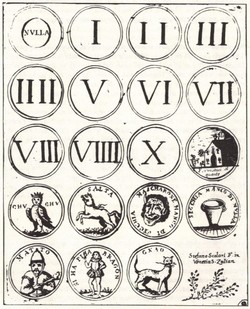
Franco Pratessi's article is of an older date (1990). As remarkable additions, partly due to recent researches, should be given:
A dice game called "Gnav", which is documented for 13th century in Bologna (see Appendix)
An article by Thierry Depaulis 1995 "Le Coucou in France", IPSC Vol. XX, pp. 22-28, with satisfying much material, that a card Malcontent / MÚcontent / Maucontent was played in France since c 1490.
The opinions of Saverio Franchi, who published an article "Le carte del Cuc¨ - Un antico gioco europeo sopravvissuto a Montorio" in "La valle dellĺalto Vomano ed i Monti della Laga", Teramo, Carsa Edizioni, I, pp. 93-115.
I haven't seen this text, but it seems, that Franchi was the first, who pointed to Luigi Tansillo, "Il Malcontento" (1547), a poem from the Naples region, in which for the current moment is seen the first evidence for the Cuc¨ game in Italy (not with the name Cuc¨, but with Malcontento). In the earlier research situation it was assumed, that Cuc¨ arrived in Italy c 1700.
The game list of Rabelais 1534, in which the game "Maucentent" is mentioned, but also the game "Cucu", as two different objects.
"a la triumphe
...
au maucontent
au lansquenet
au cocu
..
au tarau"
Au Maucontent and Cocu appear between "A la triomphe" and "au Tarau" (the both other games, which are interesting to us) very close to each other, perhaps indicating, that both are similar - in the view of Rabelais. But contradicting to this the general theory to the Cucc¨ game says, that the name Cucc¨ was introduced c. 1700.
A summarizing and useful short article by Kimihiko Kuromiya, "A Note on the History of Cucc¨" in the IPCS-Journal The Playing Card, Vol. 39 No. 4 (2011)
|
|
